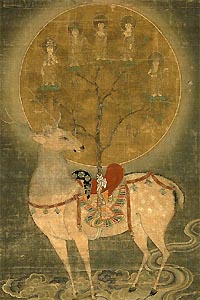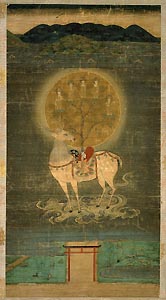 
SHINTO The Sacred Art of Ancient Japan 5 September - 2 December 2001 A key object from the medieval period is the representation on silk of the deer mandala, the embodiment of the Kasuga shrine, from the Nara National Museum. A No mask of an aged red-headed woman indicates the development of this classical drama form in the Kamakura period while a wooden model of a horse from the same period shows the continuation of the Kofun custom initiated by the Korean king of donating live horses to shrines. The Kofun ( 300 - 7th century ) period itself saw the introduction of iron production and the iron sword, bronze mirror and the jewel were subsequently adopted as the three sacred objects of Shintă. One of the 6th century mirrors on display features Shinto shrine buildings in the form of store-houses. The Chinese introduction of bronze technology to Japan during the Yayoi ( 300BC-AD300 ) period led to bronze being accorded holy status and bronze artefacts have been found ritually buried in early centres of power. The decorations on a bronze bell ( dătaku ) shows aspects of the rice culture that has greatly influenced Shinto practice. Japan´s uncharted prehistory, the Jomon period (10,000-300BC ) will also be examined through an impressive array of ceramics, including intricate *flaming pots*, decorated with human and animal forms. One of the most remarkable aspects of the exhibition is the near perfect condition of the objects on display, even those that are centuries old, by virtue of the belief that they were the properties of the gods and therefore rarely handled by mortals. Shinto, primarily a form of nature worship where natural objects are revered and personified, also encourages reverence for the spiritual elements in material objects. A key belief of Shinto is that kami (spirits) must be coaxed into inviting vessels if they are to materialise in the service of the living.
Fig.: Kasuga deer mandala. Kamakura period ( 1185-1333 ). 76.5 x 40.5cm. ę Nara National Museum
|